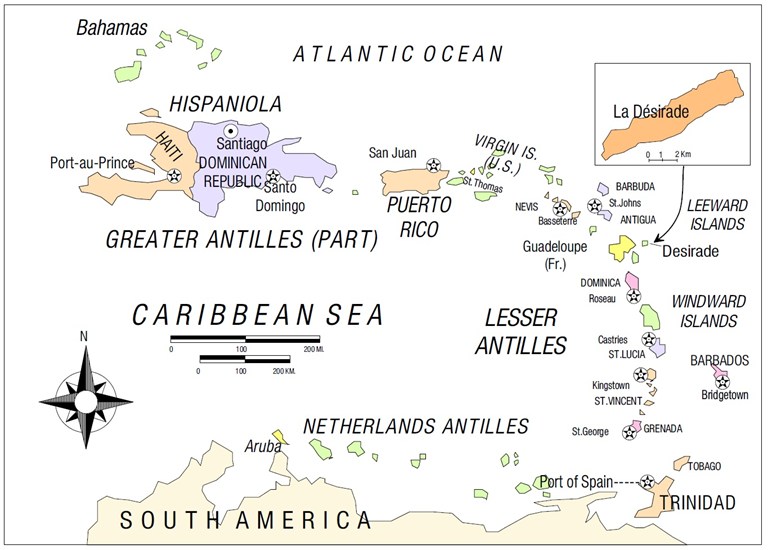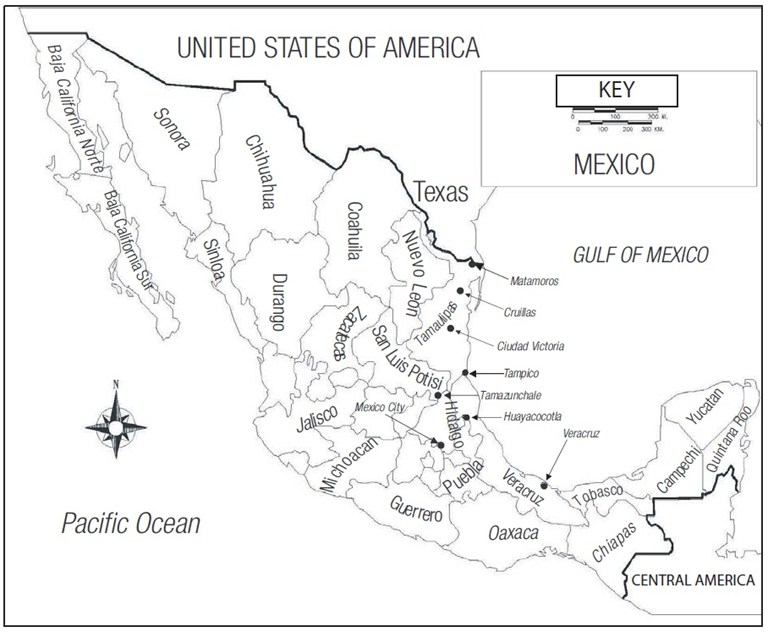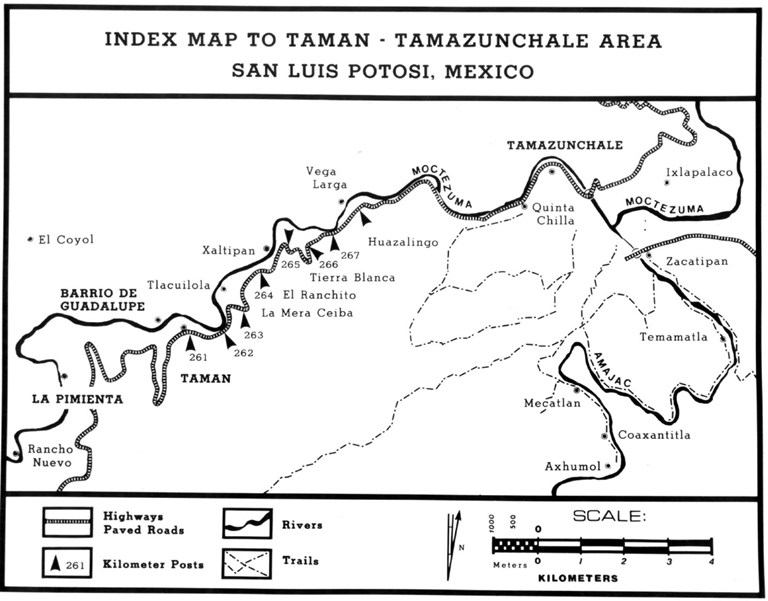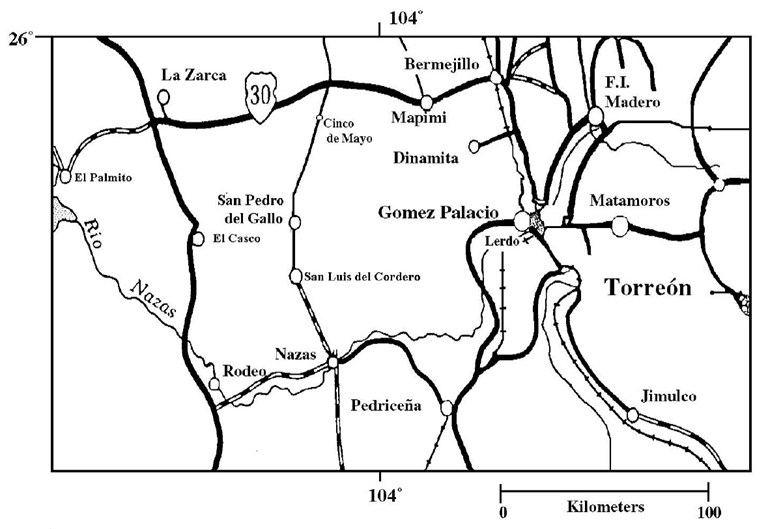Read The Apocalypse Calendar Online
Authors: Emile A. Pessagno
The Apocalypse Calendar (17 page)
Descent into the Canyon of the Río Vinasco
Friday, December 20, 2013
Miller and his group awakened at
dawn. The air outside of the Toa Vaca home was laced with the scent of pine trees that had been embraced by a light frost. At an elevation of seven thousand feet, the temperature was nearly freezing. Even in the middle of summer, it was not unusual to have temperatures in the forties at this time of day. Miller could hear the braying of burros in the background. La Señora Toa Vaca and her daughter, Rosita, prepared an enormous breakfast for everyone consisting of huevos Mexicanos, bread, and sausage. The great pile of huevos Mexicanos was made of scrambled eggs, onion, tomatoes, red peppers, and jalapeños. There was little doubt that such a breakfast would get the Apocalypse Calendar group moving. Gary suggested that with all of the jalapeños they ate, everybody should be able to float down to the bottom of the canyon. Rosita prepared the special herbal tea for Miller that was given to him by the Nahuatl curandero. The tea tasted terrible. It made him nauseous for a brief period of time.
Dolores said, “Frank, be sure to wear the amulet that the curandero gave you. Hopefully it will protect you from the ancient Mayan curse.”
“It’s around my neck. I slept with the damn thing all night!”
Guillermo Toa Vaca said, “I will accompany you down into the canyon. I’ll help keep the animals moving. I think it would be a good idea if the mules carrying the concrete went first, followed by burros. Each animal will have a handler that is familiar with all of its eccentricities. The rest of you can trail behind. If one of those mules slips, it might set off a domino-like chain reaction that would carry all of us down some two thousand feet or more to the canyon floor. As Frank and Gary know, this is extremely treacherous terrain.”
As the group descended down the trail, Miller couldn’t help but marvel again at the floral changes and climatic changes that occurred as he descended into the Canyon of the Río Vinasco. Desert-like, scruffy-looking vegetation typified by lechuguilla and cactus was sandwiched in between tall, majestic pine trees at the canyon rim and lush tropical vegetation at the canyon floor.
Miller said, “By the time you guys get close to the bottom of the canyon, you are going to want to shed some of your warm clothes. The temperature is going to be close to eighty degrees Fahrenheit, even at this time of year!”
Dolores greeted many of the Nahuatl Indians as she descended along the trail. Some answered her, smiling; others were very shy and said nothing. It paid to have these people on your side if you needed help.
When the group reached the canyon floor, Gary said, “I suggest that we camp out at La Calera near the waterfall. Frank and I found this to be a pretty good place to camp before. We can use the remnants of the old stone building as a windbreak. Let’s first set up camp. We’ll then have to move the mules and the burros upstream about five hundred yards beyond the waterfall.” By now it was about two in the afternoon. They needed to hurry if they were going to deliver the Apocalypse Calendar before the end of the day.
Guillermo said, “I’ll have the mule handlers unload the concrete at the cave entrance. I notice that there is an old washtub inside the stone building. It might be a good idea to take this thing along with us to mix the concrete in.”
After the group had traveled upstream for about fifteen minutes, Gary said, “There’s the cave entrance; you can barely see it through the tangle of vines. Some of the animal handlers are packing machetes. Get them to clear away the vines. Frank, after that, it’s your show. You should have no trouble carrying the stone box containing the calendar in your backpack. I’m going to loan you my flashlight; don’t lose it! The cave is not your messy office! I suggest that you put the box with the Calendar exactly where we found it—that is, underneath the skeleton of the Aztec war chief.”
Frank said, “I’ll do my best! If I come out of this little adventure in one piece, Gary, I think you know where I am going to put your flashlight.”
With that, Frank strapped on his backpack and grabbed the torch. As he started to enter the cave, Guillermo said, “
Vaya con Dios
.”
The cave hadn’t changed much since Frank, Gary, Arturo, and Felipe were last there some nine years ago. When Miller reached the chamber where they found the Apocalypse Calendar, the first thing that he saw was the engraving of a pyramid with a flying saucer–like object within it. A green glow was emitted from small green stones that outlined the pyramid. The skeleton of the Aztec war chief still remained on the chamber floor much as they had left it. Miller took off his backpack, removed the box containing the Apocalypse Calendar, and carefully placed it underneath the skeleton.
A microsecond later, a blinding red flash occurred; the floor of the cave chamber collapsed into a void beneath it and the entrance to the cave totally caved in. Miller felt like he was falling like a leaf from a tree; time stood still as he descended. He saw the Apocalypse Calendar and the box that contained it fall into a deep pool of clear water that was at least fifty feet deep. In his unconscious haze, he saw the Nahuatl curandero throwing incense into a fire in the center of his hut. Smoke and flashing pulses of green light emerged from the fire. He felt like he was traveling through time. He saw a large cylindrical spaceship land in the jungles of Yucatán; he saw the Apocalypse Calendar being taken to the cave by a Mayan war party; he saw the Toltec Indians removing the Apocalypse Calendar from the cave; and he saw the subsequent return of the Calendar to the cave by the badly wounded Aztec war chieftain.
When Miller came to, he was stretched out next to a small opening in the cave roof along a ridge top. A faint, but familiar, green glow was visible one hundred or more feet below him. Miller wondered how in the hell he got out of the cave; the opening was much too small for even a child to crawl through. He stood up, shouting, and waved victoriously to Gary and the others below.
At sunrise in the Canyon of the Río Vinasco, west of Veracruz, a cacophony of sound arises from the jungle. Howler monkeys screech, flocks of squawking parrots fly overhead, and every living thing awakens as dense fog begins to lift over the canopy of tropical vegetation. The sounds at the bottom of the canyon at sunrise are deafening.
On the trail above the canyon, Nahuatl Indian women and their children scurry forth to gather firewood for boiling water and cooking the first meal. Little has changed in over fifteen hundred years. In recent years, however, the Nahuatls claim that at sunset, an eerie green glow intrudes through the top of a limestone ridge and extends halfway up the canyon wall. Within this beam of green light, the Nahuatls claim that they see the image of a smiling Mayan chief with his arms outstretched in a sign of victory.
The sun is no longer blackened; the moon is no longer blood red; and the Earth is at peace with itself. The Apocalypse has ended.
This story was inspired, in part, by a woman that I met from the Mexican state of Zacatecas. The woman wanted a colleague and me to visit a goldmine near her home. She told us that at sunset, the ghost of an Indian chief appeared in front of the opening to the mine shaft.
In writing this novel, I have attempted to interweave actual events with fictional events. For example, a colleague and I were arrested by the Mexican army near Tamazunchale. We did meet anthropologists studying Indian language at the Quinta Chilla. “Voodoo Hill” at San Pedro del Gallo is a real place. I did have a dream about my former wife dressed in a bridal gown rising from her grave and beckoning me to join her. As stated in the book, some of my colleagues also had weird dreams after visiting this strange place.
The characters in this story are fictional and are often based loosely on an ensemble of people I have observed over the years.
Finally, I should add that in light of the history of the earth,
the geological events that occur in this story could actually happen
. For example, the eruption of the Yellowstone Supervolcano could quickly change the earth’s climate from warm to cold within a period of a year; the monsoon cycle in the Southern Hemisphere might cease, causing severe draught and starvation in Southeast Asia; and the overall global temperature could drop by ten degrees.
The author, Dr. Emile A. Pessagno, Jr., is a geologist who has authored well over one hundred scientific reports dealing with the geology of California, Oregon, Alaska, Mexico, the Caribbean, Argentina, Brazil, Turkey, and the Arabian Peninsula (Oman) in prominent scientific journals. His knowledge of the remote areas of Mexico adds a colorful background to this novel that few authors can supply.
Dr. Pessagno received a BA from Princeton in 1955 with a magna cum laude in Geology, an MS in Geology from Cornell in 1957, and a PhD in Geology from Princeton in 1960. He taught geology at the University of California at Davis from 1959 until 1967, at the University of Texas at Dallas, and at its predecessor, the Southwest Center for Advanced Studies, from 1967 until he retired in 2006. Dr. Pessagno is currently a Professor Emeritus at the Department of Geosciences at the University of Texas at Dallas.

Figure 1: Index Map of Caribbean.

Figure 2: Index Map of Mexico.

Figure 3: Index Map for Area around Taman and Tamazunchale, San Luis San Luis Potosí.

Figure 4: Index Map for San Pedro del Gallo--Bermejillo Area, Durango, Mexico.

Figure 5: Localities at San Pedro del Gallo, Durango, Mexico.
1 = Arroyo-”Voodoo Hill” section. 2= Cerro de La Cruz of Burckhardt (1910, 1912). 3 = Cementery and Cerro Pante´n of Burckhardt (ibid.). 4 = Cerro El Volcan or Cerro del Volcan of Burckhardt (ibid.). 5 = “Voodoo Hill”. 6 = Puerto del Cielo. 7= Airport. 8= Road connecting to highway to Mapimí. Modified from 1:50,000 San Pedro del Gallo Quadrangle (G13D23) Cetenal Carta Topografica.